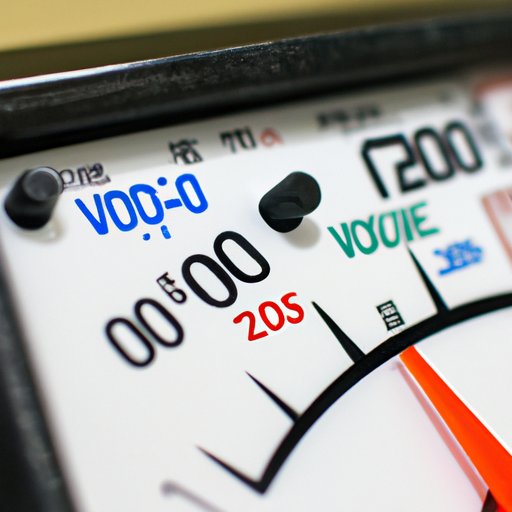
I. Introduction
Whether you’re a DIY enthusiast, an electrician, or just someone who wants to know more about electronics, understanding how to use a voltmeter is an essential skill. A voltmeter is a device used to measure electrical energy, often in the form of voltage. By using a voltmeter, you can quickly and accurately measure the voltage in an electrical circuit, helping you to identify potential problems and troubleshoot with ease. This article will provide a step-by-step guide on how to use a voltmeter, explore common mistakes to avoid, and offer advanced techniques and expert insights to help you use a voltmeter like a pro. Let’s get started!
II. A Step-by-Step Guide: How to Use a Voltmeter for Beginners
Before you start using a voltmeter, it’s important to understand the different types available. There are two primary types of voltmeters: analog and digital. Analog voltmeters use a needle to indicate the voltage level, while digital voltmeters display the voltage as a numerical value on an LCD screen.
Once you have decided which type of voltmeter you will be using, the next step is to take accurate voltage readings. Here is a step-by-step guide to help you:
- Ensure that the power is off before beginning
- Set the voltmeter to the appropriate voltage range for the circuit you are measuring. If you are not sure, start with the highest range and work down.
- Connect the probes to the circuit being measured. The red probe goes to the positive side while the black probe goes to the negative side.
- Observe the numerical or needle-based reading on the voltmeter, then record it for future reference.
- Disconnect the probes and remember to power off any circuits, devices, or equipment before leaving them unattended.
It’s important to interpret your readings and know what to do with them. If your reading is higher or lower than the expected range, you may need to troubleshoot the related electrical component further.
III. Common Mistakes to Avoid When Using a Voltmeter
Although voltmeters are relatively easy to use, there are some common mistakes that even experienced professionals can make. Some of the most common mistakes include:
- Leaving the voltmeter connected to a powered circuit
- Misreading the voltage range setting on the voltmeter
- Using a damaged or faulty voltmeter
- Leaving the probes loose or touching each other while measuring a circuit
To avoid these mistakes, always follow the instructions provided by the manufacturer and double-check your settings. It can also be helpful to test your voltmeter before using it on sensitive circuits to ensure it’s working properly.
IV. Advanced Techniques: Using a Voltmeter to Troubleshoot Electrical Problems
One of the significant advantages of using a voltmeter is the ability to troubleshoot electrical problems quickly and accurately. Here’s how you can do it:
- Identify the suspected component or circuit
- Measure the voltage across the component or circuit
- If the voltage reading is too low or non-existent, you have a problem with the related component or circuit
- If the voltage reading is too high, you may have a short circuit or another issue
By following these steps, you can identify electrical problems quickly, helping you to stay safe and avoid costly repairs.
V. Safety First: How to Use a Voltmeter Safely
When using a voltmeter or other electrical tool, safety should always come first. Here are some essential safety tips to keep in mind:
- Always wear safety glasses and gloves when working with electrical components
- Avoid using voltmeters in wet environments or near water
- Always power off any circuits or devices before measuring voltage levels
- Always double-check your voltage range settings to ensure you’re testing in the right range
- Respect the voltage ranges you are testing and be aware of the risks involved
By following these safety measures, you can prevent serious injuries and stay safe while working with electrical components.
VI. Expert Insights: Tips and Tricks for Using a Voltmeter like a Pro
Seasoned professionals often have insider tips and tricks that can make using a voltmeter simpler and more effective. Here are a few expert insights to help you use a voltmeter like a pro:
- Use the right probes. There are specific probes for different kinds of testing, so be sure to use the correct ones.
- Ensure your probes are clean and free of any dirt or debris that could interfere with readings
- Use a voltage tester to confirm that the power is off before you start working
- Always work methodically and logically, measuring one component or circuit at a time
By following these tips and tricks, you can use a voltmeter more effectively and troubleshoot electrical problems with greater ease.
VII. Conclusion
Using a voltmeter is a crucial part of electrical troubleshooting, whether you’re a novice DIYer or a seasoned electrician. By following the steps outlined in this article, avoiding common mistakes, using advanced techniques to troubleshoot problems, and practicing safe techniques, you can become proficient in using a voltmeter. Remember, safety always comes first when working with electrical components. With these expert insights and tips, you can use a voltmeter like a pro and take your electrical skills to the next level.




